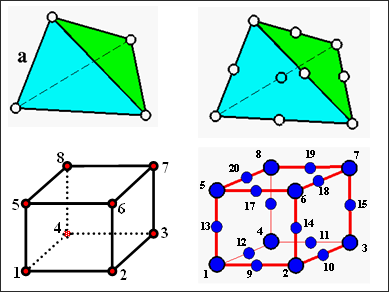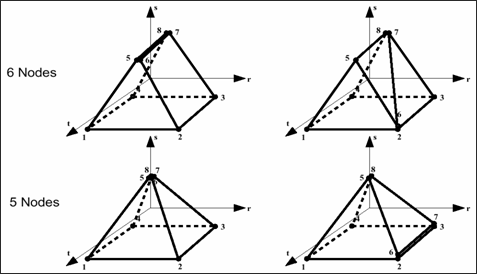Solid Elements (/PROP/SOLID) |

|

|

|

|
|
Solid Elements (/PROP/SOLID) |

|

|

|

|
Solids hexahedron and tetrahedron with linear and quadratic interpolation functions are available in RADIOSS (Fig. 2.1). Linear elements are better in terms of time and memory consumption, especially due to the low number of integration points and a larger time step (![]() ):
):
| • | TETRA4:  |
| • | TETRA10:  |
| • | BRICK8:  |
| • | BRICK20: |
Table 2.1 summarizes the differences between theses elements. For BRICK8, the use of co-rotational formulation is explained in the RADIOSS Theory Manual; which can avoid the accumulation of an error, due to the updating process, especially when elements undergo large shear deformation. The formulation is not used by default for this element and should be activated by you.

Fig. 2.1: Solid finite element meshes in RADIOSS
Solid elements can be degenerated to overpass some meshing problems. Degenerated elements can be obtained by merging nodes on a same edge (hexahedron) or suppressing a middle node in a TETRA10. The use of degenerated elements is not recommended, but if they cannot be avoided due to complex geometry, it is important to respect the element symmetry to keep a homogenous mass distribution. Some examples of degenerated solid elements are shown in the following figure.

Fig. 2.2: Examples of solid elements degeneration
Mesh |
Element Name |
Number of |
Hourglass Formulation |
Comments |
|---|---|---|---|---|
|
BRICK8 |
1x1x1 2x2x2 |
Penalty for the case of 1 IP |
Use co-rotational formulation. Avoid hourglass type 2 |
HA8 |
from 2x2x2 to 9x9x9 |
--- |
Note the value used for the flag, Icpre |
|
HEPH |
1x1x1 |
Physical stabilization |
||
|
BRICK20 |
2x2x2 |
--- |
Too high cost element |
|
TETRA4 |
1 |
--- |
Shear locking in large deformation Low precision element |
|
TETRA20 |
4 |
--- |
High cost Good precision without shear locking |
Table 2.1: Solid elements